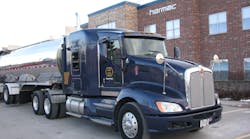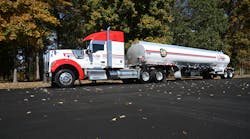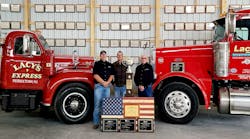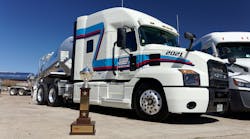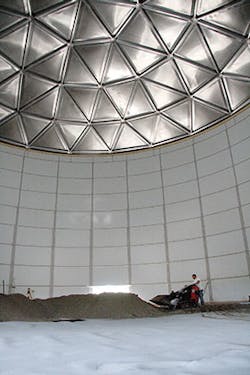FACILITIES with storage tanks need managers who will ask even the most basic questions, according to Jeff McGill, manager of environmental compliance for Sunoco Logistics.
“There are inspections and audits,” he said. “You need to be prepared for that. This is your facility. You need to know the answers to these questions.”
McGill, who led a seminar during the International Liquid Terminals Association’s 2013 International Operating Conference entitled “Determining Storage Tank Emissions for Heated Oil and Asphalt,” said the questions include:
• What do you store in your storage tanks?
• How do you know what you store in your storage tanks?
• Do you have an air permit for your storage tanks?
• Does your air permit specify what products you store?
• Is the vapor pressure of the product you store something you know?
• How do you know the vapor pressure of what you store?
• Is the vapor pressure important to know?
• Do you have any emission limits for your tanks?
• Do you report emissions for your tanks?
• Who calculates the emissions for your tanks?
• What data is used when the emissions are calculated?
• Do you use a computer program to calculate the emissions?
• Do you use emission factors to calculate emissions?
• How do you know the emission factors are good to use?
• Are these questions important to your environmental group, operations group, business planning group, engineering group—or all?
“The answers to each of those questions are not the same for everyone,” he said. “There is no one-size-fits-all answer. Circumstances such as tank age, specific geographic location, products/business you are in, individual permits, and which specific rules you fall under can influence what is actually required. Sometimes the responses are site-specific, and sometimes the answers may be tank-specific. You should not be painted into a corner on these topics, but you do need to have a response to these questions that you can support.
“Understand what you do now, and how you do it. Be aware that there may be different ways to do things. Over time emission methods may change due to a multitude of different reasons. When emission factors change, a review of the impact on each facility will be necessary. If the operator runs into issues or questions, it may be a good time to conduct outreach to a trade group to see if others are encountering the same issues and may be of assistance.”
McGill said that understanding the vapor pressure of the #6 oil is an important variable in the emission estimates. If #6 oil is blended with a cutter stock, it may be necessary to review the blend ratio and the properties of the cutter stock, and calculate the vapor pressure taking into account the percentage of the vapor pressure of the cutter stock.
“Until new factors are published for #6 oil- and asphalt-heated tanks, be sure to document the factors you do use to report emissions so there is no misunderstanding as to the basis for your estimates,” he said. “Special care should be taken when pursuing a permit for any new construction.
Storage tank emissions page 2...
“ILTA is commissioning a work group to explore the recent information compiled through field testing, existing emission models, and potential options to develop a new model for the emission estimates of #6 oil and asphalt.”
Elizabeth Hernberg, Sprague Energy’s managing director, said her company had arduous experiences with a specific emphasis on #6 oil and asphalt in heated tanks.
Sprague has supplied petroleum-based products in the northeast as a distributor of refined products and currently owns and/or operates 15 strategically located marine terminals in the Northeast and Canada, including several that store heated products such as #6 oil and asphalt.
Sprague received the first of a series of Section 114 letters in December 2010.
Hernberg said the petroleum industry has traditionally relied on the TANKS models to predict and report volatile organic compound (VOC) emissions for heated products and to establish permit conditions. In 2007 and 2008, The Environmental Protection Agency’s (EPA) Region 1 (New England) received evidence of much higher emissions from a Region 1 #6 oil terminal through the self-reporting mechanism.
She said this facility employed a vapor system, designed initially for odor abatement, which later graduated to a more elaborate vacuum capture system that could also conveniently measure VOC emissions, which triggered self-disclosure.
Hernberg said Region 1 claimed that TANKS under-predicts #6 oil VOC and HAP emissions because #6 oil product characteristics have changed over the 30 years since the TANKS parameters were set, with vapor pressures and elevated product temperatures not factored into the TANKS algorithm.
Section 114 letters (the first of three letters) were issued by Region 1 starting in late 2010 to #6 fuel oil terminals—a reporting requirement for 10 years of historical records and physical product testing requirement for all tanks and all incoming shipments for six months.
One year later, the EPA required Sprague to develop a test methodology and conduct field tests on heated tank-breathing during static and fill conditions.
“The initial results from the field testing were inconclusive for static tank breathing,” she said. “The methodology introduced a significant upward bias in emissions flow rates.
“Like most of you, we take pride in compliance. We are passionate about finding an answer and want to know if there are ways we can control emissions. But the more we got into the process, we believed this investigation resembled more of a science project than a compliance investigation.
“We didn’t know but eventually learned about the shortcomings of the tank’s model, which is used throughout the industry to predict emissions. But we also hold state permits that stipulate that we use tanks to estimate and record VOC emissions. We learned that temperatures and vapor pressures of #6 oil are actually lower in the model than in practice, which results in lower emission estimates. We had numerous discussions with the DOT that we were using tanks like the rest of the industry, and the fact that the tank’s models actually featured in several areas on EPA’s website was surprisingly not a defense to Region 1.”
She said that from a regional perspective, New England represents only 1% of the total US #6 oil sales and exports, and its annual #6 oil throughput is roughly PADD 3’s weekly throughput.
“Based on this mix, it was curious that EPA Region 1—a direct overlay to PADD 1A—would be pursuing the #6 oil issue,” she said. “It showed us this emissions investigation was actually homegrown in Region 1. They discovered it and chose to pursue it themselves, and it was irrespective of other usage across the country. We felt they took a rather confined approach, with limited outside influence, and led us toward an emissions profile which we felt was very narrow and actually flawed.”
She said the overall effort has come at a “significant cost” to Sprague, both in expenditures and resources.
“Early in 2012, we were stumped on an approach, because it was clearly a path not taken in any industry in North America,” she said. “EPA originally said we could develop and submit our own protocol for sampling, so we spent a great deal of time trying to get a sampling program right, considering what was at stake. The most substantial and controversial part of this investigation has been a second testing order. EPA required that we conduct continuous testing for VOCs on a #6 tank and asphalt tank each for 30 days.”
The EPA Section 114 testing order in Searsport, Maine, involved vessel transfer: test emissions levels (VOC and HAP concentrations) at all tank vents during vessel transfer; and calculate the flow rate based on the product discharge rate into the tank (assumed to equal vapor emissions rate).
Tank breathing involved: testing emissions levels at all tank vents, calculating the flow rate over a 30-day time frame and sampling VOC and HAP concentrations.
Truck transfer involved: testing emissions levels at the truck hatch; calculating the flow rate based on the product discharge rate into truck (assumed to equal vapor emissions rate); and monitoring conducted for 10 truck fills or until results were repeatable.
“While determining emissions rates is straightforward for vessel transfer and truck loading—the transfer rate of product fill—tank breathing rates are weak, barely detectable with sensitive equipment and extremely erratic,” she said. “Standing emissions testing under static conditions is unprecedented; no methodology is available or has been used to detect the very low flow rates of tank exhalation and inhalation.
“EPA required that Sprague apply a protocol designed for controlled and indoor environments that relies on a fan to draw vapors from temporary total enclosures (TTE) encapsulating the storage tank vents. Sprague’s air consultant expressed several concerns to EPA about the fan device and likelihood that vapors would be induced. Sprague initially proposed a methodology that would not induce flow, yet EPA rejected it in favor of the TTE approach.
“The results of about one ton per year each for vessel transfer and truck fill appear reasonable based on the transfer rates and emissions sampling. Breathing losses per tank are still undetermined. A direct measure experiment involved inserting a simple pitot tube to measure velocity pressure. In this experiment, flow was not detected, therefore we used the detection level as the most conservative rate. That resulted in 4.4 tons of VOC emissions per storage tank per year.”
She said Sprague learned a lot about emissions during the times when the velocity of flow is changed, when fan speed was actually increased.
Storage tank emissions page 3...
“Fan speed has a direct correlation to emissions rates,” she said. “Fan speed was increased during vessel transfer in order to maintain the slight vacuum on the system during rapid vapor displacement. The fan remained on ‘high’ for several hours after the vessel transfer, with elevated emissions. Once the fan speed was reduced, there was a stepwise change in emissions rates.
“We kind of got an a-ha moment. We felt it clearly proved a direct correlation between fan speed and emissions rating. This bothered us, because we felt it confirmed that when we had a fan that was drawing vapors out, we actually were inducing emissions and oversampling.”
Sprague’s lessons learned:
• Get out in front of issues before they become larger concerns (ie, neighborhood odor issues).
• Maintain active dialogue with the agency to obtain more detail and work through requirements. “Regulators were very receptive to meeting with us and listening to our point of view,” she said. “We didn’t go away from all meetings in full agreement, but we ended up developing a pretty good relationship with them.”
• Clarify assumptions when providing responses in writing.
• Seek legal advice.
• Submit requests for related documentation under the Freedom of Information Act (FOIA).
• Seek extensions when needed. “Mostly, it was areas around emissions testing, because we wanted to draw a number of expert opinions and make sure we were going down the right path.”
• Get others involved in the industry and the Congressional delegation.
• Don’t assume that full compliance with EPA guidance provides a cover for enforcement activities.
Traci Johnson, environmental technical director for International-Matex Tank Terminals, said her company set out to demonstrate that heated heavy-fuel tanks did not in fact breathe out 24 hours a day.
“The concentration of emissions over a 24-hour are pretty consistent to indicate the tank is breathing out 24 hours a day,” she said. “However, we knew instinctively that for a tank to breathe out, at some point it has to breathe in as well, so we set out to evaluate the appropriateness of EPA Method 204.”
They monitored temperatures of the tank liquid, tank vapor, and vent vapor.
Their general observations:
• Heated and insulated fixed-roof tanks breathe during static conditions.
• Temperature changes in the vapor space appear to drive breathing. There is diurnal effect on tank vapor space. Tank vapor temperature maxes around 2 pm and is at the minimum around 2 am. Pipe vapor temperature was indicative of diurnal breathing and mixing with ambient air.
“Our observations are qualitative, not quantitative,” she said. “Additional data is required for predictive modeling purposes.” ♦



